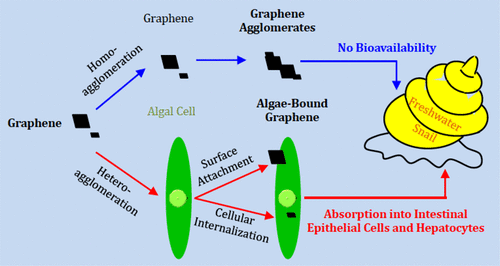当前位置:
X-MOL 学术
›
Environ. Sci. Technol.
›
论文详情
Our official English website, www.x-mol.net, welcomes your feedback! (Note: you will need to create a separate account there.)
Green Algae as Carriers Enhance the Bioavailability of 14C-Labeled Few-Layer Graphene to Freshwater Snails
Environmental Science & Technology ( IF 11.4 ) Pub Date : 2018-01-12 00:00:00 , DOI: 10.1021/acs.est.7b05796 Yu Su 1 , Xin Tong 1 , Chi Huang 1 , Jiani Chen 2 , Sijin Liu 3 , Shixiang Gao 1 , Liang Mao 1 , Baoshan Xing 4
Environmental Science & Technology ( IF 11.4 ) Pub Date : 2018-01-12 00:00:00 , DOI: 10.1021/acs.est.7b05796 Yu Su 1 , Xin Tong 1 , Chi Huang 1 , Jiani Chen 2 , Sijin Liu 3 , Shixiang Gao 1 , Liang Mao 1 , Baoshan Xing 4
Affiliation

|
The waterborne exposure of graphene to ecological receptors has received much attention; however, little is known about the contribution of food to the bioaccumulation potential of graphene. We investigated the effect of algal food on the uptake and distribution of 14C-labeled few-layer graphene (FLG) in freshwater snails, a favorite food for Asian people. In a water-only system, FLG (∼158 μg/L) was ingested by and accumulated in the snails. Adding algae to the water significantly enhanced FLG accumulation in the snails, with a bioaccumulation factor of 2.7 (48 h exposure). Approximately 92.5% of the accumulated FLG was retained in the intestine; in particular, the accumulated FLG in the intestine was able to pass through the intestinal wall and enter the intestinal epithelial cells. Of them, 1.3% was subsequently transferred/internalized to the liver/hepatocytes, a process that was not observed in the absence of the algae. Characterizations data further suggested that both of the extra- and intracellular FLG in the algae (the algae-bound fraction was 30.2%) significantly contributed to the bioaccumulation. Our results provide the first evidence that algae as carriers enhanced FLG bioavailability to the snails, as well as the potential of FLG exposure to human beings through consuming the contaminated snails.
中文翻译:

绿藻作为载体增强了14 C标签的少层石墨烯对淡水蜗牛的生物利用度
石墨烯在水环境中暴露于生态受体受到了广泛关注。然而,人们对食物对石墨烯生物蓄积潜力的贡献知之甚少。我们调查了藻类食物对14种食物摄取和分布的影响淡水蜗牛中C标记的几层石墨烯(FLG),这是亚洲人最喜欢的食物。在纯水系统中,蜗牛吸收并积累了FLG(〜158μg/ L)。向水中添加藻类可显着增强蜗牛中FLG的积累,其生物积累因子为2.7(暴露48小时)。大约92.5%的累积FLG保留在肠中;特别地,在肠中累积的FLG能够穿过肠壁并进入肠上皮细胞。其中1.3%随后被转移/内在化至肝/肝细胞,在没有藻类的情况下未观察到这一过程。特征数据进一步表明,藻类中的细胞外和细胞内FLG(藻类结合率均为30.2%)均显着促进了生物积累。
更新日期:2018-01-12
中文翻译:

绿藻作为载体增强了14 C标签的少层石墨烯对淡水蜗牛的生物利用度
石墨烯在水环境中暴露于生态受体受到了广泛关注。然而,人们对食物对石墨烯生物蓄积潜力的贡献知之甚少。我们调查了藻类食物对14种食物摄取和分布的影响淡水蜗牛中C标记的几层石墨烯(FLG),这是亚洲人最喜欢的食物。在纯水系统中,蜗牛吸收并积累了FLG(〜158μg/ L)。向水中添加藻类可显着增强蜗牛中FLG的积累,其生物积累因子为2.7(暴露48小时)。大约92.5%的累积FLG保留在肠中;特别地,在肠中累积的FLG能够穿过肠壁并进入肠上皮细胞。其中1.3%随后被转移/内在化至肝/肝细胞,在没有藻类的情况下未观察到这一过程。特征数据进一步表明,藻类中的细胞外和细胞内FLG(藻类结合率均为30.2%)均显着促进了生物积累。



























 京公网安备 11010802027423号
京公网安备 11010802027423号